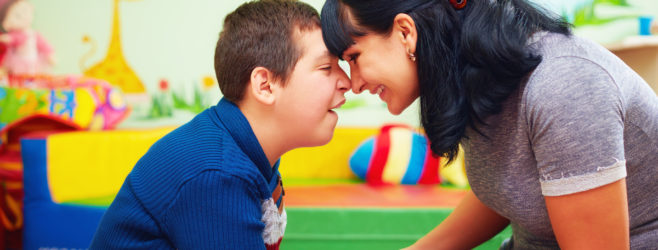If your child has cerebral palsy, it is your responsibility to make sure their medical and educational needs are met by working with doctors and teachers. You can also explore other ways to make a difference — whether by joining a cerebral palsy advocacy group or taking legal action on your child’s behalf. See all the ways you can become a cerebral palsy advocate today.
1. Advocate for Your Child’s Health Needs
Cerebral palsy is a group of disorders that affects each person differently, so the symptoms and related health problems can vary greatly.
To make sure your child gets the best health care possible, you’ll need to understand their specific symptoms and what you can do to manage them. It also means working closely with your child’s doctors to manage these symptoms.
As your child’s parent — and cerebral palsy advocate — you are their primary caregiver and ultimately make the decisions on what is best for them. If a doctor recommends a treatment that you or your child is not comfortable with, it is your job to discuss those concerns.
You can also help your child out by seeking out different forms of therapy, which can help manage symptoms alongside regular medical care.
Cerebral palsy therapies include:
- Aquatic therapy
- Physical therapy
- Occupational therapy
- Speech therapy
You can help support your child’s therapy sessions by learning if certain exercises can be done at home. Reach out to a cerebral palsy therapist to learn more.
Another way to advocate for your child’s health is by seeking out support groups. Cerebral palsy support groups allow children to find strength from others with this condition. This can have positive benefits on their mental and emotional well-being.
There are also support groups for family members, where you can learn how to be a better cerebral palsy advocate by learning from more experienced parents and caregivers.
2. Support Your Child’s Education Needs
Your child may also need a cerebral palsy advocate when going to school as they may face learning challenges if they are mentally impaired. There are several special education resources for students with cerebral palsy.
Here are some of the options you may consider:
- 504 plans: 504 plans allow children with cerebral palsy and other disabilities to learn with their able-bodied peers. Children with 504 plans may get extra accommodations (like speech therapy and special classes) to help them learn effectively.
- Cerebral palsy schools: These schools are tailor-made for those with cerebral palsy. On-staff are teachers and medical professionals that specifically help cerebral palsy patients manage their symptoms and learn more effectively.
- Individualized education plans (IEPS): An IEP is a school program developed for children with special needs. Unlike 504 plans, IEPs are customized to fit the needs of each child in mind.
Other options also exist, including homeschooling. As your child’s cerebral palsy advocate, you should investigate all the possible education plans that are available and choose one that will best fit your child’s needs.
Choosing an education plan is just the first step, though. It’s important to make sure your child succeeds in their education goals as they move forward in school. This includes working with your child’s teachers and making sure the education plan in place is a good fit.
3. Support or Join a Cerebral Palsy Advocacy Group
A cerebral palsy advocacy group is an organization that encourages acceptance of those with this condition and pushes for changes to improve their lives.
These changes can come by supporting new laws that help those with cerebral palsy or other disabilities, sponsoring research, or hosting awareness events.
By supporting or joining these groups, you can help make changes at the local, state, and federal levels. There are a variety of different cerebral palsy advocacy groups.
The list includes:
- American Academy for Cerebral Palsy and Developmental Medicine (AACPDM): This organization helps sponsor medical research relevant to cerebral palsy.
- American Speech-Language-Hearing Association (ASHA): This organization focuses on making effective communication a human right, especially for those with disabilities like cerebral palsy.
- United Cerebral Palsy (UCP): UCP is a national group that helps those with cerebral palsy via local chapters throughout the country.
You can either donate to groups like UCP or join the AACPDM or ASHA for a fee.
4. Explore Your Cerebral Palsy Legal Options
In some cases, your child’s cerebral palsy (or another birth injury) may have been caused by medical negligence. In these instances, you can advocate for your child’s rights through the legal system.
For example, by filing a lawsuit, you may be able to access money to pay for your child’s treatments or therapies. These lawsuits hold those who harmed your child financially accountable.
In 2020, a 15-year-old with cerebral palsy received over $15 Million after his family filed a lawsuit, claiming medical negligence led to his condition.
In a recent interview, the boy’s mother said: “My son has waited so long for justice.”
It may be possible for you to win compensation to pay for your child’s medical or living expenses as well. Learn more about filing a lawsuit with a free legal case review.
Next Steps to Become a Cerebral Palsy Advocate
Becoming a cerebral palsy advocate is important for your child’s long term success. From guiding their medical care to fighting for justice through the legal system, being a cerebral palsy advocate allows you to support your child no matter what challenges they face.
You can learn more about becoming an advocate for your child by contacting or team today.
We can provide you with information about:
- Doctors & treatments
- Education plans
- Legal help
- Support groups
- Other resources
We want to help your child reach his or her potential. By learning more about these important topics, you can maximize your child’s abilities and help them develop new skills.



